Stockton-on-Tees
Stockton-on-Tees is a large market town in County Durham, England. The town has a population of 85,000, with a population of around 196,000 in the wider area, the Borough of Stockton-on-Tees, according to 2017 estimates by ONS UK.
| Stockton-on-Tees | |
|---|---|
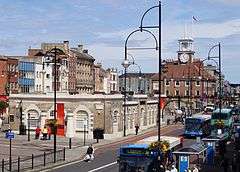 Stockton-on-Tees town centre | |
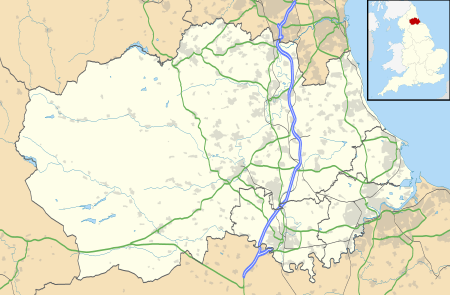 Stockton-on-Tees Location within County Durham | |
| Population | 85,000 |
| OS grid reference | NZ440200 |
| • London | 252.5m |
| Unitary authority | |
| Ceremonial county | |
| Region | |
| Country | England |
| Sovereign state | United Kingdom |
| Post town | STOCKTON-ON-TEES |
| Postcode district | TS16–TS21 |
| Dialling code | 01642 |
| Police | Cleveland |
| Fire | Cleveland |
| Ambulance | North East |
| UK Parliament | |
History
Etymology
Stockton is an Anglo-Saxon name with the typical Anglo-Saxon place name ending 'ton' meaning farm, or homestead.
The name is thought by some to derive from the Anglo-Saxon word Stocc meaning log, tree trunk or wooden post. 'Stockton' could therefore mean a farm built of logs. This is disputed, because when the word Stocc forms the first part of a place name it usually indicates a derivation from the similar word Stoc, meaning cell, monastery or place. 'Stoc' names along with places called Stoke or Stow, usually indicate farms which belonged to a manor or religious house. It is thought that Stockton fell into this category and perhaps the name is an indication that Stockton was an outpost of Durham or Norton which were both important Anglo-Saxon centres. This is a matter of dispute, but Stockton was only a part of Norton until the eighteenth century, when it became an independent parish in its own right. Today the roles have been reversed and Norton has been demoted to a part of Stockton.
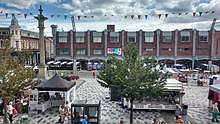
Prehistory
Stockton is known to be the home of the fossilised remains of the most northerly hippopotamus ever discovered on Earth. In 1958, an archeological dig four miles north-west of the town discovered a molar tooth from a hippo dating back 125,000 years ago. However, no-one knows where exactly the tooth was discovered, who discovered it, or why the dig took place. The tooth was sent to the borough's librarian and curator, G. F. Leighton, who then sent to the Natural History Museum, London. Since then the tooth has been missing, and people are trying to rediscover it.[1][2]
Early history
Stockton began as an Anglo-Saxon settlement on high ground close to the northern bank of the River Tees.
The manor of Stockton was created around 1138 and was purchased by Bishop Pudsey of Durham in 1189. During the 13th century, the bishop turned the village of Stockton into a borough. When the bishop freed the serfs of Stockton, craftsmen came to live in the new town. The bishop had a residence in Stockton Castle, which was just a fortified manor house. The first recorded reference to the castle was in 1376.
Stockton's market can trace its history to 1310,[3] when Bishop Bek of Durham granted a market charter – to our town of Stockton a market upon every Wednesday for ever. The town grew into a busy little port, exporting wool and importing wine which was demanded by the upper class. However even by the standards of the time, medieval Stockton-on-Tees was a small town with a population of only around 1,000, and did not grow any larger for centuries.
The Scots captured Stockton Castle in 1644 and occupied it until 1646. It was destroyed at the order of Oliver Cromwell at the end of the Civil War. A shopping centre, the Castlegate Centre, now occupies the castle area. No known accurate depictions of the castle exist.[4][5]
The Town House was built in 1735 and the first theatre in Stockton opened in 1766. In 1771, a five arch stone bridge was built replacing the nearby Bishop's Ferry. Until the opening of the Middlesbrough Transporter Bridge in 1911, this was the lowest bridging point on the Tees. From the end of the 18th century the Industrial Revolution changed Stockton from a small and quiet market town into a flourishing centre of heavy industry.
Industrial history
Shipbuilding in Stockton, which had begun in the 15th century, prospered in the 17th and 18th centuries. Smaller-scale industries began developing around this time, such as brick, sail and rope making, the latter reflected in road names such as Ropery Street in the town centre. Stockton became the major port for County Durham, the North Riding of Yorkshire and Westmorland during this period, exporting mainly rope made in the town, agricultural produce and lead from the Yorkshire Dales.[6]
The town grew rapidly as the Industrial Revolution progressed, with iron making and engineering beginning in the town in the 18th century. The town's population grew from 10,000 in 1851 to over 50,000 in 1901 as workers moved in. The discovery of iron ore in the Eston Hills resulted in blast furnaces lining the River Tees from Stockton to the river's mouth. In 1820 an Act set up the Commissioners, a body with responsibility for lighting and cleaning the streets. From 1822 Stockton-on-Tees was lit by gas.[7]
.jpg)
In 1822, Stockton witnessed an event which changed the face of the world forever and heralded the dawn of a new era in trade, industry and travel. The first rail of George Stephenson's Stockton and Darlington Railway was laid near St. John's crossing on Bridge Road. Hauled by Locomotion No 1, the great engineer himself manned the engine on its first journey on 27 September 1825.[8] Fellow engineer and friend, Timothy Hackworth acted as guard. This was the world's first passenger railway, connecting Stockton with Shildon. The opening of the railway greatly boosted Stockton, making it easier to bring coal to the factories; however the port declined as business had moved down river to Middlesbrough.
Stockton witnessed another discovery in 1827. Local chemist John Walker invented the friction match in his shop at 59 High Street. The first sale of the matches was recorded in his sales-book on 7 April 1827, to a Mr. Hixon, a solicitor in the town. Since he did not obtain a patent, Walker received neither fame nor wealth for his invention, but he was able to retire some years before his death. He died in 1859 at the age of 78 and is buried in the parish churchyard in Norton village.
The first bell for Big Ben was cast by John Warner and Sons in Norton on 6 August 1856, but became damaged beyond repair while being tested on site and had to be replaced by a foundry more local to Westminster.[9] A hospital opened in Stockton in 1862 and a public library opened in 1877.[10]
Steam trams began running in the streets in 1881 and were replaced by electric trams in 1897. Buses replaced the trams in 1931. In the 1930s slums were cleared and the first council houses were built. At this time, Stockton was still dominated by the engineering industry and there was also a chemicals industry in the town. In the late 20th century manufacturing industry severely declined, although the service industries grew, and today are the town's main employers.
On 10 September 1933 the Battle of Stockton took place, in which between 200 and 300 supporters of the British Union of Fascists were taken to Stockton and attempted to hold a rally in the town, but they were driven out by up to 2,000 anti-fascist demonstrators.
The Ragworth district near the town centre was the scene of rioting in July 1992, when local youths threw stones at buildings, set cars alight and threw missiles at police and fire crews. The area later saw a £12million regeneration which involved mass demolition or refurbishment of the existing properties, as well as new housing and community facilities being built.[11]
It became a unitary authority on 1 April 1996 and part of the Tees Valley region. For ceremonial purposes the borough is split between County Durham and North Yorkshire, along the line of the River Tees as shown in the map (left) with County Durham to the north and North Yorkshire to the south. It is the only council area in England or Wales to be split between two ceremonial counties.
Geography
Stockton is located on the north bank of the River Tees. The town's extreme northern and western areas are located on slightly higher ground than the town centre, which is located directly on the north bank of the Tees. These offer views of the town with its relatively mid-rise centre and the surrounding Tees Valley area.
The town has many suburbs with individual identities: Fairfield, Grangefield, Hardwick, Hartburn, Elm Tree Farm, Norton, Roseworth, Newtown, Bishopsgarth and Oxbridge to name a few. Within the borough, but distinct settlements from the town of Stockton, are Thornaby-on-Tees, Ingleby Barwick, Billingham and Yarm, with Thornaby-on-Tees, Yarm-on-Tees and Ingleby Barwick being within the boundaries of the North Riding of Yorkshire until 1 April 1974. On 23 January 2020, the town was the epicentre for an earthquake measuring 2.8 on the Richter scale.[12]
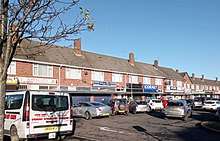
Climate
Stockton-on-Tees has an oceanic climate typical for the United Kingdom. Being sheltered by both the Lake District and Pennines to the west, Stockton is in one of the relatively drier parts of the country, receiving on average 25 inches (643 millimetres) of rain a year. It has more of a continental climate than other parts of the UK, with above average summer temperatures, and below average winter temperatures. Summer highs typically reach around 20 °C (68 °F), while winter lows can fall to several degrees below 0 °C (32 °F). The Köppen Climate Classification subtype for this climate is "Cfb" (Marine West Coast Climate).[13]
| Climate data for Stockton-on-Tees | |||||||||||||
|---|---|---|---|---|---|---|---|---|---|---|---|---|---|
| Month | Jan | Feb | Mar | Apr | May | Jun | Jul | Aug | Sep | Oct | Nov | Dec | Year |
| Average high °C (°F) | 7 (45) |
7 (45) |
9 (48) |
11 (52) |
15 (59) |
18 (64) |
20 (68) |
20 (68) |
17 (63) |
13 (55) |
9 (48) |
6 (43) |
12.5 (54.5) |
| Average low °C (°F) | 2 (36) |
2 (36) |
3 (37) |
4 (39) |
7 (45) |
9 (48) |
11 (52) |
12 (54) |
10 (50) |
7 (45) |
4 (39) |
2 (36) |
6 (43) |
| Average precipitation mm (inches) | 47.2 (1.86) |
33.1 (1.30) |
44.2 (1.74) |
48.3 (1.90) |
39.0 (1.54) |
72.9 (2.87) |
68.9 (2.71) |
64.3 (2.53) |
50.0 (1.97) |
64.9 (2.56) |
59.6 (2.35) |
51.2 (2.02) |
643.6 (25.34) |
| Source: [14] | |||||||||||||
Town centre
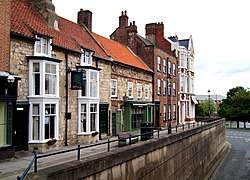
Stockton town centre is the main centre within the borough. High Street, which is the widest in the UK,[15] heads north through the town centre, from the junction of Bridge Road and Yarm Lane, culminating at Maxwells Corner, where Norton Road and Bishopton Lane begin. Dovecot Street runs west from the midway point of High Street and further north, Church Road extends east toward Northshore and the River Tees. At the heart of High Street stands the town hall, which dates from 1735 and the Georgian-style Shambles Market Hall. Around the town hall, the largest outdoor market in the north east of England, which has been in existence since the 1300s, is held every Wednesday and Saturday.[16]
From High Street, the town spreads outwards to the west as far as Leeds Street and Prince Regent Street, and to the east as far as Riverside, with the River Tees beyond. Most of the town centre has a Georgian and late medieval influence, with a number of listed buildings as well as a variety of architectural types, which help to define the town's identity. The shops predominantly have narrow frontages stretching back to gain floorspace. This burgage plot style is particularly evident around the marketplace and on side streets such as Silver Street, Finkle Street and Ramsgate.
The town centre retail is largely concentrated within two shopping centres, Castlegate and Wellington Square. The Castlegate is a building, whilst Wellington Square have open shops on pedestrian-only paths. The Castlegate Centre occupies the area where Stockton Castle once stood. Opened in 1972, it incorporates a multi-storey car park and an indoor market. Its façade is a dominant feature along the south east of High Street and is bounded by Finkle Street, Bridge Road and Tower Street. Riverside and the River Tees run almost parallel to the rear of the centre. The Teesquay Millennium Footbridge links the rear of the Castlegate Centre to Castlegate Quay on the north side of the river and then onto Teesdale Business Park and the Durham University - Queen's Campus on the south side in the Ceremonial County of North Yorkshire. Situated at the north west end of the town centre is Wellington Square shopping centre, built upon the old Wellington Street area of the town centre. Opened in 2001 at a cost of £43 million, it provides 46 shop units, anchored by Debenham's car parking.
The town centre has retained a number of the original yards such as Wasp Nest Yard, Hambletonian Yard and Ship Inn Yard that would have historically been a feature. Most interesting is Green Dragon Yard, a courtyard of restored historic warehouses within a series of alleyways. Considered the cultural quarter of the town, it houses the Green Dragon pub, the Green Dragon Studios (recording studios) and the Georgian Theatre – Britain's oldest surviving Georgian theatre.
As well as providing commercial retail facilities, Stockton town centre also provides a variety of services including national banks and building societies, travel agents, a central post office, hairdressers and beauticians, cafes and restaurants. The refurbishment of some period buildings has provided space for small firms including solicitors, recruitment agencies and accountants.
Riverside
Since the construction of the Tees Barrage in 1995, the level of the River Tees through the town is permanently held at high tide, creating a backdrop for riverside events and making it useful for a number of water sport activities such as rowing, canoeing, jet skiing and dragon boat racing. Stockton town centre is elevated high above the river and is separated from the riverside by the A1305 Riverside Road, a dual carriageway which runs parallel to the river from Northshore to Chandlers Wharf.

From the town centre, Bishop Street, Silver Street, Calverts Lane and Thistle Green offer views of the river where it meanders around Teesdale Business Park. Durham University Queens Campus can be seen on the opposite side, as well as the skyline of Middlesbrough in the middle distance and Roseberry Topping in the Cleveland Hills, approximately fifteen miles south east in the far distance. The 11-metre Aeolian Motion wind sculpture stands above the grassy slope which overlooks the riverside and becomes an amphitheatre during large events.
Chandlers Wharf is situated at the north side of the river, where Bridge Road approaches Victoria Bridge. The area is characterised by a mixture of office and residential accommodation, including the colourful twelve-storey Mezzino student apartments at Rialto Court, a Mecca Bingo hall, Burger King and the two-storey Grosvenor Casino which opened in September 2011. Adjacent to the wharf is Castlegate Quay which was once the towns main dock. The quayside is still occupied by Georgian warehouses which have been converted into a number of business units, restaurants and a gym. A full-size replica of local-born Captain James Cook's ship HM Bark Endeavour was once moored at the quayside but was sold and moved after refurbishment to a mooring in Whitby North Yorkshire. The Teesside Princess, a two-deck river boat, docks alongside and offers river cruises to Yarm, via Preston Park all year round.

Both the north and south banks of the river are retained by steel sheet pile walls and have footpaths along the river edge. The Tees Walkway on the north bank of the river can be accessed from the town centre by the Teesquay Millennium Footbridge or the Riverside Footbridge and provides a walk along the embankment, as well as a cycle path which forms part of the National Cycle Network. From Castlegate Quay, the tree-lined path along the waterfront toward the Princess of Wales Bridge opens into green space for events and a car parking area. Beyond the Princess of Wales Bridge, the slipway at the River Tees Watersports Centre is situated at the western area of Northshore, which is currently development and leads up to the Tees Barrage.
Transport
The town is served by two main arterial roads: the transpennine A66 (east/west) and the A19 (north/south). The A66 connects Stockton directly to Middlesbrough (8 miles to the east) and Darlington (10 miles to the west). A link road has recently been completed which connects the A66 with the town centre and Ingleby Barwick. This road has been numbered the A135 (and named '1825 Way' in commemoration of the Stockton and Darlington Railway), replacing the old A135 route which was previously the A19. The old A135 has been renumbered the A1027, which continues on through the town to Billingham. The A19 connects Stockton with York in the south and extends to Peterlee and Sunderland, further north.
East of the town centre is the A1046, a mostly dual carriageway which runs through Portrack as Portrack Lane, a major retail destination, mainly in home furnishings and DIY. From Portrack, the A1046 continues on to its northern terminus at Port Clarence. The A139 connects the town centre with the northern suburb of Norton. This road was the original route for the A19 before a bypass was built to the east of the town. The A177 runs from Stockton town centre to Durham. Known as Durham Road, it passes Sedgefield on the way and acts as a major route to the town. Several miles to the west of the town is the A1(M) Motorway.
A number of bus services operate in Stockton and most services pass through High Street. The services cover large areas of the region including Middlesbrough, Teesside Park, Thornaby, Billingham, Sedgefield, Durham, Sunderland, Peterlee and Newcastle upon Tyne. Among the companies operating bus services, Stagecoach on Teesside and Arriva North East are the major providers, while six minor providers also operate in the area.[17]
Stockton railway station serves the town, but more regular and distant services are operated from nearby Thornaby. Teesside International Airport, is partially located within the borough, several miles west of the town. The airport offers domestic and international flights, the latter particularly to EU countries.
Education
Economy
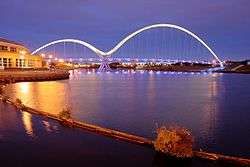
Stockton is famous for its associations with the friction match and the Stockton and Darlington Railway, which operated the world's first steam-hauled passenger train in 1825 and the town also has the world's oldest passenger railway station building. Major industries in Stockton have included ship building and repairing, heavy engineering as well as steel and chemicals manufacturing, however during the twentieth century the town's heavy industry declined dramatically, along with that of the surrounding Teesside area.
Situated away from the town centre towards the A19 is HMP Holme House, a large Category B local prison for male adult prisoners who are either remanded in custody or convicted. It also accommodates a small number of Young Offenders aged 18–21 years. A purpose built prison which opened in May 1992, it serves primarily the communities of the Tees Valley, South West Durham, East Durham and North Yorkshire.
Development
Since the 1980s Stockton has seen an increase in service industries. The development of Teesdale Business Park on the south bank of the River Tees has created commercial space with many large service providers locating call centres and offices in the area. [6] Durham University's Queen's Campus is also situated within the Teesdale development which is linked to the town centre by the Teesquay Millennium Footbridge, Princess of Wales Bridge and the Infinity Bridge. In 1995, after four years in the building, the Tees Barrage was commissioned, permanently holding the upstream river waters at the level of an average high tide.
Future development
Work is under way to develop the north bank of the River Tees in Stockton with the £300 million Northshore scheme, which will include new offices, leisure facilities, housing, a 150-bedroom hotel and a new campus for Durham University.[18][19][20]
In 2012, a long-term scheme aimed at transforming the town centre area was announced, with investment of around £38m. Stockton Borough Council will contribute just over £20m, with the remainder from the private sector and grants. The investment programme aims to attract more retailers, businesses and shoppers to the town by opening up new spaces and links to the River Tees, providing easier access and parking and building on the town's heritage and cultural assets. It will take advantage of its location close to the River Tees, Stockton's 700 years as a market town, and its reputation as a centre for performing arts. The scheme is expected to be complete by 2015.
Plans include the introduction of an expansive plaza area 'Infinity View' that will open up the pedestrian area to dramatic views of the award-winning and iconic Infinity Bridge. Under the scheme, the banks of the River Tees will be transformed with a series of impressive light installations which will stretch along the waterfront, from the Princess of Wales Bridge to the Millennium Bridge. This permanent colourful illumination is intended to add value to the riverside businesses and restaurants and play an important part in the council's events programme throughout the year.[21]
Stockton is one of 12 towns in England to share in £1.2m of funding, support from retail guru Mary Portas and her own team, as part of the Portas Pilot scheme. Selected from over 370 applications, Stockton's Town Team Consortium, comprising Stockton Council, Tees Music Alliance, Durham University Queen's Campus, town centre retailers, A Way Out and Stockton Heritage in Partnership, will have the opportunity to share in expert advice and guidance from a range of retail experts.[22][23]
The Stockton-Middlesbrough Initiative[24] is a 20-year vision for regenerating the urban core of the Tees Valley, the main focus being the 30 km2 (12 sq mi) area along the banks of the River Tees between the two centres of Stockton and Middlesbrough. The master plan has been drawn up by environmental design specialists Gillespies,[25] the eventual aim being to bring distinctive high-quality city-scale assets to the centre of the Tees Valley, including the town centres of Stockton and Middlesbrough. The project will include the existing developments at North Shore,[26] Stockton and Middlesbrough,[27] with many others over a 15- to 20-year period.
In February 2020 it was announced that the Castlegate Shopping Centre is set to be demolished in 2022.[28]
Culture and community
Culture
There are a number of nightclubs and bars in the town centre, particularly at the southern end of High Street. Stockton also provides a number of restaurants, amusement arcades, a bingo hall, a snooker club, and health and fitness facilities.
Festivals and fairs
Stockton Calling is an annual day long music festival, across a number of Stockton's music venues, which takes has taken place every Easter Sunday since 2010.[29] In 2019 it celebrated its 11th year and was headlined by Sophie & the Giants.[29]
The Stockton International Riverside Festival (SIRF), one of Europe's largest open air festivals, takes over the town once a year since 1988.[30] Spread over a long weekend, for either four or five-days, it attracts over 250,000 visitors and features a variety of acts from a circus, comedy, music, dance and street theatre.[31]
The annual riverside firework display happens on the first Sunday closest to 5 November and is attended by up to 100,000 spectators from the wider region. The year's events always conclude with the Stockton Sparkles Christmas Festival and the associated markets.[32][33]
Theatres & Music Venues
The ARC Theatre & Arts Centre on Dovecot Street was built in 1999 and comprises a multi-purpose arts centre embracing cinema, theatre, dance and music. It has three floors offering four venues: a 260-seat theatre, a 100-seat studio theatre, the point/music area accommodating 550 standing, and the cinema, seating 130. It also has exhibition spaces, meeting rooms, a café and two bars.
The Georgian Theatre at Green Dragon Yard is also Grade II listed and is the oldest Georgian theatre in the country. Originally opened in 1766, it fell into disrepair during the 19th century but later became used as a sweet factory and then a community building. Between 2007 and 2008 the building was given a full makeover along with its neighbour Green Dragon Studios and now serves as an intimate venue for live entertainment, with a capacity of 200.
The Globe Theatre is at the north western end of the High Street and is currently closed whilst undergoing restoration. A Grade II listed theatre built in 1936 on the same site as two previous theatres, it has hosted many famous acts such as Buddy Holly, the Platters, Guy Mitchell, the Rolling Stones, the Animals, Cilla Black, Carl Perkins, Cliff Richard, the Shadows and Chuck Berry. The Beatles famously played the Globe on Friday 22 November 1963, the day U. S. President John F. Kennedy was assassinated.
Community facilities
Public services provided in Stockton include a general hospital, health advice centres, dental and medical surgeries, a library, churches, employment advice centres, youth projects, energy advice centres and an international family centre. The cluster of municipal buildings are concentrated primarily along Church Road. The police headquarters is the only emergency service station located within the centre, next to Stockton Central Library.
The University Hospital of North Tees is located in the town and serves south east County Durham. It is part of the North Tees and Hartlepool NHS Trust.
Public parks
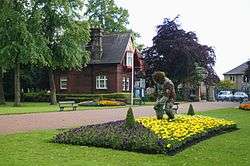
Stockton has a number of public parks and nature reserves. Most notable is Ropner Park, a Victorian-style park, located on the outskirts of the town, near Hartburn village. Opened in 1893 and renovated in 2007, the park has tree-lined avenues approaching an ornate water fountain, surrounded by rockeries and floral displays. Overlooking the lake, the bandstand provides live band music on Sunday afternoons, during the summer months. Seasonal fairs and occasional organised events are staged at the park throughout the year.
Further upstream is Preston Park, a 100-acre (0.40 km2) public park located next to the River Tees. The park hosts many events each year that attract people from across Teesside and further afield. Preston Hall, once the home of Sir Robert Ropner, is situated within the grounds and is now a museum. The park also houses 'Butterfly World' an artificial tropical environment, housing various species of exotic butterflies and reptiles.
Downstream on the River Tees is Portrack Marsh Nature Reserve, a 50 acres (20 ha)[34][35] nature reserve by the northern bank of the river between the Tees Barrage and the Tees Viaduct near Portrack housing estate. It is the last remaining wetland on the lower Tees.[36] Ownership of the reserve is split between Tees Valley Wildlife Trust and Northumbrian Water, but the reserve is managed by Tees Valley Wildlife Trust. The west and north part of the reserve is mature marsh while there are a series of man – made ponds in the remainder.
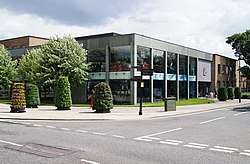
Leisure facilities
The town's main leisure facility is 'Splash', a large wet and dry facility situated on Church Road which includes a 25-metre pool with wave machine and flumes, a learner pool and a spa pool, a two-storey fitness facility, dry multi-activity spaces, café and Sportwall & Dance facilities. The Castlegate Quay Watersports Centre offers opportunities for sailing and paddling on the River Tees.[37]
Libraries
Stockton Central Library, situated on Church Road, is the largest public library serving the borough of Stockton-on-Tees.[38] Built in 1967, it was fully refurbished in 2011 at a cost of £1.9m. It occupies two floors; the ground floor incorporates Stockton Borough Council's Customer Services Centre and Cashiers, an adult lending library and a children's library. The first floor houses the reference library which is the central reference department for the borough, a family history suite, a computer suite which offers free internet access and also the 'Starbooks' cafe. The library also provides conference facilities and an exhibition area.
Landmarks
Public Art
Stockton Flyer
On 12 June 2016, Stockton Council launched The Stockton Flyer, a large industrial looking flying train which was constructed and then lowered inside a plinth on the Stockton High Street. It was officially unveiled to mark the Queen's official 90th birthday on 12 June 2016. The Stockton Flyer appears every day in the town centre at 1pm,[39][40] usually with an audience of people videoing the rising and lowering of the structure. The train's whistles and horns are audible over a mile and a half away.
Sport
Stockton Cricket Club was established in 1816, and has been located at the Grangefield Cricket Ground, Grangefield since 1891. The club currently fields three senior teams at weekends in the 1st, 2nd and 3rd Divisions of the Dukes North East Premier League.
Stockton Football Club existed from 1882 until it folded 1975. They played at the Victoria Ground which also held greyhound racing (one of two venues in the town to do so along with Belle Vue Park (Stockton-on-Tees)).[41][42][43][44] The clubs assets were transferred to Norton Cricket Club, who subsequently founded the Norton & Stockton Ancients. There are two other football clubs in the town. Stockton Town F.C. play in the Northern League Division One after consecutive promotions winning the Wearside League in 2016 and Northern League Division 2 in 2017 and Stockton West End who currently play in the North Riding Football League Premier Division.
Stockton Rugby Club is the local Rugby Union side, established in 1873. Home games are now played at the Grangefield Ground following a historic community partnership agreement with Stockton Cricket club and Grangefield Academy in 2015.
Notable people
People born in Stockton include:
- Francis Arthur Bainbridge, physiologist
- Neal Bishop, footballer
- C. J. Bolland, electronic music producer in Belgium
- Daniel Casey, actor
- Ivy Close, actress
- Edward Cooper, soldier, recipient of the Victoria Cross.[45]
- Brass Crosby, Lord Mayor of London
- Freddie Dixon, motorcycle and car racing driver[46]
- Lesley Duncan, pop singer-songwriter
- Maurice Elvey, film director
- Charles Foulkes, Canadian General
- James Gaddas, actor
- Martin Gray, footballer
- Will Hay, comic actor
- Richard Anthony Hewson, jazz-funk music producer
- Thomas Hornby, cricketer
- Robert Icke, director and writer
- David Ingman, engineer, Chairman of the British Waterways Board 1987-1993
- Heather Ingman, Professor of English, novelist and journalist
- Jimmy James, comedian
- Jessie Joe Jacobs, charity leader and politician
- Richard Kilty, sprinter
- Jordan Nobbs, footballer
- Geoff Parling, England and British Lions rugby player
- Luke Pearson, cartoonist
- Colin Renfrew, archaeologist
- Joseph Ritson, literary critic and editor
- Franc Roddam, film director/producer[47]
- Graham Rowntree, England rugby player
- Thomas Sheraton, furniture designer
- Paul Smith, singer in rock band Maximo Park
- Peter Smithson, architect
- Calvert Spensley, American politician
- Bill Steer, co-founder and lead guitarist of extreme metal band Carcass.
- Jeremy Swift, actor
- Bruce Thomas, new wave bass guitar backing musician
- Denis Thwaites, footballer murdered in the 2015 Sousse attacks[48]
- Stephen Tompkinson, actor[49]
- John Walker, inventor of the friction match
Other notable residents include:
- Duncan Bannatyne, entrepreneur, moved to Stockton when he was 30, before he made his fortune
- Matthew Bates, footballer
- Lee Cattermole, footballer
- William Christopher, Hudson's Bay Company captain and explorer[50]
- Elizabeth Estensen, actress
- Jonathan Franks, footballer
- Don Heath, footballer, winner of the League Cup in 1969, when his Swindon team beat Arsenal 3-1
- Harold Macmillan, MP for the town (1924–29, 1931–45), later Prime Minister (1957–63), created Earl of Stockton (1984)
- Michael Marks, founder of Marks & Spencer, started his business career in Stockton in 1883
- George Orwell, author, resided for a year (1944–45) in Greystones, near Carlton, a village in the borough
- Bill Rodgers, Baron Rodgers of Quarry Bank, MP for the town (1962–83), co-founder of the SDP
- Ridley Scott and Tony Scott, film directors, both lived in Stockton during their youth[51]
- Lee Turnbull, footballer
Image gallery
 Splash Leisure Centre, Church Road
Splash Leisure Centre, Church Road Green Dragon Yard
Green Dragon Yard Mezzino student apartments and Chandlers Wharf
Mezzino student apartments and Chandlers Wharf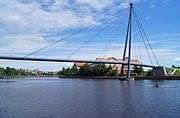 Teesquay Millennium Bridge
Teesquay Millennium Bridge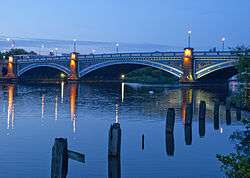 Victoria Bridge
Victoria Bridge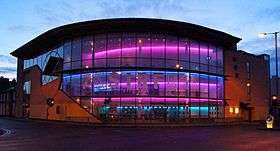 The ARC Theatre & Arts Centre, Dovecot Street
The ARC Theatre & Arts Centre, Dovecot Street
References
- "The 'Stockton Hippo': 5 questions answered by university professor". Stockton-on-Tees Borough Council. 14 May 2018. Retrieved 16 May 2018.
- Brown, Mike (29 April 2018). "Stockton is believed to be the most northerly place on the planet where hippos lived - but crucial evidence to prove it has gone missing". Teesside Gazette. Retrieved 16 May 2018.
- "Heritage". Rediscover Stockton. 17 December 2015. Archived from the original on 3 March 2016. Retrieved 14 January 2016.
- Archived 6 October 2008 at the Wayback Machine
- "Stockton Castle - Discover Stockton on Tees | At The Heart of Teesside and the Tees Valley". Stocktonteesside.co.uk. 27 July 2014. Retrieved 14 January 2016.
- "Stockton-on-Tees, Billingham and Norton". Englandsnortheast.co.uk. Retrieved 8 November 2011.
- Britain, Great (2 July 1822). "The Statutes of the United Kingdom of Great Britain and Ireland" – via Google Books.
- "Stockton: Where Passenger Railways Began - Stockton Heritage".
- "THE STORY OF BIG BEN". whitechapelbellfoundry.co.uk. Retrieved 8 November 2011.
- "Stockton History Timeline".
- Live, Teesside (1 December 2010). "We're talking up Ragworth". gazettelive.
- "Stockton earthquake: Tremor shakes homes on Teesside". BBC. 23 January 2020. Retrieved 23 January 2020.
- "Travel Weather Averages (Weatherbase)". Weatherbase. Archived from the original on 13 July 2013. Retrieved 12 July 2013.
- "Monthly Climate Averages". worldweatheronline.com. Retrieved 2 July 2012.
- "Stockton Town Centre". Stockton Borough Council. Archived from the original on 14 October 2012. Retrieved 28 July 2012.
- "Parishes – Stockton on Tees | British History Online". British-history.ac.uk. Retrieved 8 November 2011.
- "Buses – Stockton Borough Council". Public Transport. Stockton-on-Tees Borough Council. 10 August 2007. Archived from the original on 27 October 2007. Retrieved 27 October 2007.
- "Northshore - Stockton Council". Stockton.gov.uk. Archived from the original on 13 September 2014. Retrieved 13 September 2014.
- "NORTHSHORE". Northshore Stockton. Retrieved 13 September 2014.
- "Northshore, Stockton-on-Tees Muse Developments". Musedevelopments.com. Archived from the original on 9 October 2011. Retrieved 8 November 2011.
- "Our plans for Stockton Town Centre". Stockton Borough Council. May 2012.
- "High Streets to share £1.2m funding". BBC. 26 May 2012.
- "Portas pilot - Stockton-on-Tees". Stockton Borough Council. May 2012.
- "Stockton-Middlesbrough Initiative website". Smi-teesvalley.co.uk. 26 March 2010. Archived from the original on 4 October 2011. Retrieved 8 November 2011.
- "Gillespies website". Gillespies.co.uk. Retrieved 8 November 2011.
- "North Shore website". Teesvalleyregeneration.co.uk. Archived from the original on 2 July 2007. Retrieved 8 November 2011.
- Middlehaven, Middlesbrough project website
- Metcalfe, Alex (21 February 2020). "It's official - Stockton's Castlegate will be demolished in 2022". gazettelive. Retrieved 22 February 2020.
- Brown, Mike (17 January 2020). "Stockton Calling set for another big year as headline acts announced". gazettelive. Retrieved 31 January 2020.
- "Stockton International Riverside Festival | Stockton events". events.stockton.gov.uk. Retrieved 31 January 2020.
- Welford, Joanne (29 July 2019). "Stockton International Riverside Festival: All you need to know". gazettelive. Retrieved 31 January 2020.
- "SIRF Fringe Festival". Archived from the original on 31 July 2008. Retrieved 2 August 2008.
- "Stockton Sparkles | Stockton events". events.stockton.gov.uk. Retrieved 31 January 2020.
- Sharples, Garry. "Birds of Portrack Marsh and Tees Barrage" (PDF). Teesmouth Bird Club. Retrieved 30 June 2009.
- Sharp, Chris (2006). "Teesmouth Bird Club Newsletter, Issue 34" (PDF). Teesmouth Bird Club. Retrieved 1 August 2010.
- "A Guide to Zoos and Aquariums 2008" (PDF). Group Travel Organiser. 2008. Archived from the original (PDF) on 3 December 2008. Retrieved 1 August 2010.
- administrator. "Castlegate Quay Watersports Centre". This is Stockton on Tees. Retrieved 28 February 2020.
- "Stockton Central Library and Customer Service Centre - Stockton Council".
- "Stockton Flyer prepares for launch". www.stockton.gov.uk.
- "Stockton Flyer mechanical train structure to be unveiled on day of Queen's Birthday celebrations in Stockton". www.thenorthernecho.co.uk.
- "OS Plan Partial 1960-1970". old-maps.co.uk.
- "The Millfield Scrap Metal Works, Stockton-on-Tees, 1950". Britain from Above.
- "Victoria Ground, Stockton". Teesside Live.
- Barnes, Julia (1988). Daily Mirror Greyhound Fact File. Ringpress Books. ISBN 0-948955-15-5.
- "Sergeant Edward Cooper". Krrcassociation.com. King's Royal Rifle Corps Association. Archived from the original on 23 February 2014. Retrieved 8 June 2013.
- "Local History of Stockton Borough". Stockton Council. Archived from the original on 27 April 2012. Retrieved 21 December 2011.
- Barnes, Henry (9 November 2011). "Franc Roddam: from parkas to the perfect souffle" – via The Guardian.
- https://www.independent.co.uk/news/people/denis-thwaites-fast-and-skilful-footballer-who-played-for-birmingham-city-and-was-murdered-in-a-10359142.html
- Dale, Sarah (16 October 2013). "Stephen Tompkinson: Teesside actor promotes new film Harrigan at the Arc in Stockton". Gazette Live. Retrieved 14 January 2016.
- "William Christopher". Captain Cook Society. Retrieved 24 October 2019.
- Barley, Sophie. "Stockton bus routes named after Tony and Ridley Scott". Gazette Live. Retrieved 14 January 2016.
External links
| Wikivoyage has a travel guide for Stockton-on-Tees. |
- Stockton-on-Tees Borough Council
- Stockton-on-Tees at Curlie
- Stockton-on-Tees in the development of the north-eastern coast
- Historical data for Stockton-on-Tees
- BBC Tees – the latest local news, sport, entertainment, features, faith, travel and weather.